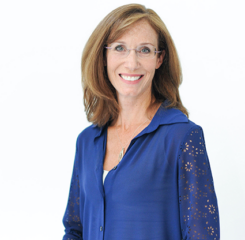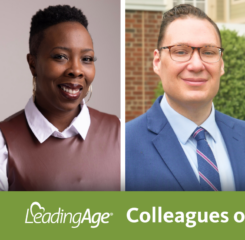FutureCAST Interviews David Belbeck and Dusanka Delovska-Trajkova
In this month’s FutureCAST interviews, two experts discuss their most exciting initiatives and impressions on CAST’s impact. Susheel Ladwa, Chief Editor at DistilNFO and co-chair of the America’s Health Insurance Plans (AHIP) IT Advisory Group, who was formerly with IBM Cloud Services, speaks with these executives:
- David Belbeck, EVP, Corporate Development at PointClickCare, a LeadingAge Gold Partner with CAST Focus.
- Dusanka Delovska-Trajkova, Chief Information Officer at CAST Patron Ingleside.
FutureCAST is a CAST video series asking 24 health care executives where they think health care technology is headed and how CAST can play a role. These interviews were held at the 2017 LeadingAge Annual Meeting & EXPO. Each issue of Tech Time in 2018 will feature two insightful interviews.
David Belbeck, EVP, Corporate Development, PointClickCare
David Belbeck is EVP, Corporate Development at PointClickCare, a LeadingAge Gold Partner with CAST Focus. He leads a team of professionals responsible for establishing and advancing strategic partner relationships as well as identifying and developing new market opportunities. As a seasoned veteran within the technology sector, Belbeck plays a significant role in strategic growth planning for the business.
Watch the video, and read the full transcript.
Ladwa: What’s the most exciting thing that you and your team are working on currently?
Belback: The industry is going through a transformation, and we have a number of initiatives. Our seventh annual customer summit is bringing together more than 1,700 customers, partners, and employees. There, we’re looking to engage in conversations with customers around how we solve some industry problems, the reality of changing payment models, value-based care, the reality of narrowing networks, and how our customers can deal with that challenge.
The summit addresses some of the solutions that we’re bringing to help our customers deal with those problems. One example is a partnership we have with COMS interactive to bring evidence-based proactive care management and disease protocols to our customer base. Another is our skin wound solution, which helps our customers to provide better care and reduce clinical risk when managing wounds in their facilities.
We have a new document management solution that helps our customers develop a more-efficient and a more-accurate admissions process in their facilities, and we have an employee engagement and customer satisfaction solution. The number one problem we hear people talk about is how they can attract and retain staff in a world where volume is growing and a caregiver shortage is pending, and so that’s a solution we think is very important for our customers.
We’re also introducing an enhanced home health solution, PointClickCare at Home. Historically, we’ve served our customers with a view that we want them to be able to provide the best care with the best outcomes regardless of care setting. Most of our customers either have a home health operation or are growing their home health business, as providers are trying to be able to manage patients and residents across the entire continuum of care.
Part one of our home health solution is a home health solution that provides our customers with a modern mobile app that allows caregivers to document in the home with fewer documentation errors, better compliance, and better billing. It allows us to help solve customer problems around the quality of documentation as well as to thrive in a world where networks are narrowing and our customers need to compete to be a part of preferred provider networks.
Part two is a remote care solution that allows individuals to live at home more safely and more effectively. It provides our home health customers with the ability to remotely monitor client activity and adherence to care plans and to decide to intervene if the data shows the potential for an adverse event that may cause a readmission.
We’re pretty excited about those two PointClickCare at Home solutions.
Ladwa: What is the impact LeadingAge CAST has on your strategies, your investments, and your vision?
Belbeck: I think CAST has brought a lot of value to its members, notably in launching its seven-stage electronic health records (EHR) adoption model. That’s really a model that helps providers to walk through in a logical manner the implementation of an EHR and really get value from the EHR implementation.
At PointClickCare, we embrace the model. We built the concepts into the way we build our platform, implement and work with customers, and engage our account management team. We continue to help customers to walk down the path, get better value out of the EHR, and achieve greater connectivity so that they can effectively interoperate with hospitals, pharmacies, and other settings of care.
To learn more about Belbeck’s background, advice to healthcare executives in times of uncertainty, and recommendations for younger executives, watch the video, and read the full transcript.
Dusanka Delovska-Trajkova, Chief Information Officer (CIO), Ingleside
Dusanka Delovska-Trajkova, Chief Information Officer at CAST Business Associate Ingleside, has more than 25 years’ experience in computer science and automation in a variety of environments—corporate, government, educational and nonprofit—in Macedonia and the United States. Her tenure with the Ingleside family includes four years leading IT for Ingleside at King Farm at Rockville, MD, before accepting the Ingleside CIO position in 2012.
Watch the video, and read the full transcript.
Ladwa: What is the most exciting thing that you’re working on at Ingleside?
Delovska-Trajkova: Ingleside is a system of Senior Living Life Plan Communities with a multi-site, multi-regional campus, with campuses in DC, Maryland, and Virginia.
The most challenging and most exciting is the building of two additions to the campuses in DC and Maryland. And the campus in Virginia, we are restructuring for the needs of the 21st century and the baby boomer generations. On top of that, we worked on multiple projects including analytics providing better analytics and better data mining for our executive teams particularly; but also that trickles down to the lower, and the lowest level of staff.
Ladwa: When you usually have multi-sites, then you have older applications, there is a lot of work involved in unifying IT systems. What’s your view about consolidating across multiple applications and unifying for multi-site?
Delovska-Trajkova: Having individual systems obviously is an obstacle to efficient work. So it was our imperative to integrate an interface to all our systems—not only to have two systems talk to each other on a network level, but also on the highest level, the application level.
We face challenges with partners when these disparate systems don’t talk to each other. And we are very advanced in what can be invested in senior living in an interoperability platform. Two of our campuses participate in the health information exchange (HIE), which is state and regional health information exchange.
We are exchanging data with hospitals. However, there’s a long way in front of us in really making these systems to work when there are no standards, when there is no foundational work being set up by others. So, we’re doing the best we can to make technology a utility for our staff, instead of them seeing it as an obstacle in addition to their workload.
Ladwa: From your standpoint, what are the top technology trends that are going to impact this industry?
Delovska-Trajkova: Nonprofits are slow in adopting changes, because of lack of standards and lack of funding. We need to really work hard and change the culture. The challenges are multifold. But also we need to really invest in training and education; not only staff, but also our clients.
With the age of breaches and HIPAA, now people are more aware of technology. With the development of mobile technology, they use at home, so they wanted us to use it at work. So it’s big. It’s not the same. When you use it at home, it works. There are challenges with interoperability, with interfacing, with safety and security, accessibility. We have clients who have a lot of chronic diseases such as vision and hearing issues. Adapting our systems to provide access to these clients is also one of the opportunities.
Ladwa: You’ve been associated with LeadingAge CAST for quite some time now. What impact has CAST had on your technology strategy?
Delovska-Trajkova: CAST was very helpful in providing us foundational and research work that we don’t have time to do, and we didn’t have access to.
The traditional research was not focused on senior living. So this was a fresh of breath air to have somebody actually looking at different systems and giving advice and guidelines to companies such as senior living without extensive IT support and technology support.
We call CAST when we have issues or need some advice on which way to go. They provide case studies to us, so we can look at others’ experiences. They also give us access to technology that is not widely accessible or known, and access to partners.
CAST has many providers on board, and there is an advantage to us because we don’t have the time to do diligent research to make the right choices sometimes. I think that’s the most benefit that we get from CAST.
To learn more about Delovska-Trajkova’s background and advice to younger executives, watch the video, and read the full transcript.
Interested in Hearing from Delovska-Trajkova and PointClickCare?
If you are interested hearing from Delovska-Trajkova and PointClickCare, read our article on the LTPAC Health IT Summit. Then register today to attend the Summit, which will take place June 24-26, 2018, at the Washington Hilton Hotel in Washington, DC.

Most Recommended
October 15, 2025
 Shutdown Week Three: Impact of Ongoing Closure on Affordable Housing
Shutdown Week Three: Impact of Ongoing Closure on Affordable Housing
December 10, 2025
Fiscal Year (FY) Funding 2026
October 07, 2025
Immigrant Workforce Matching Program Brings Workforce Relief
Recently Added
January 08, 2026
Cybersecurity Step One: A HIPAA Security Risk Analysis
January 07, 2026
Nominate a Growing Leader for the 2026 LeadingAge Leadership Award
January 07, 2026



